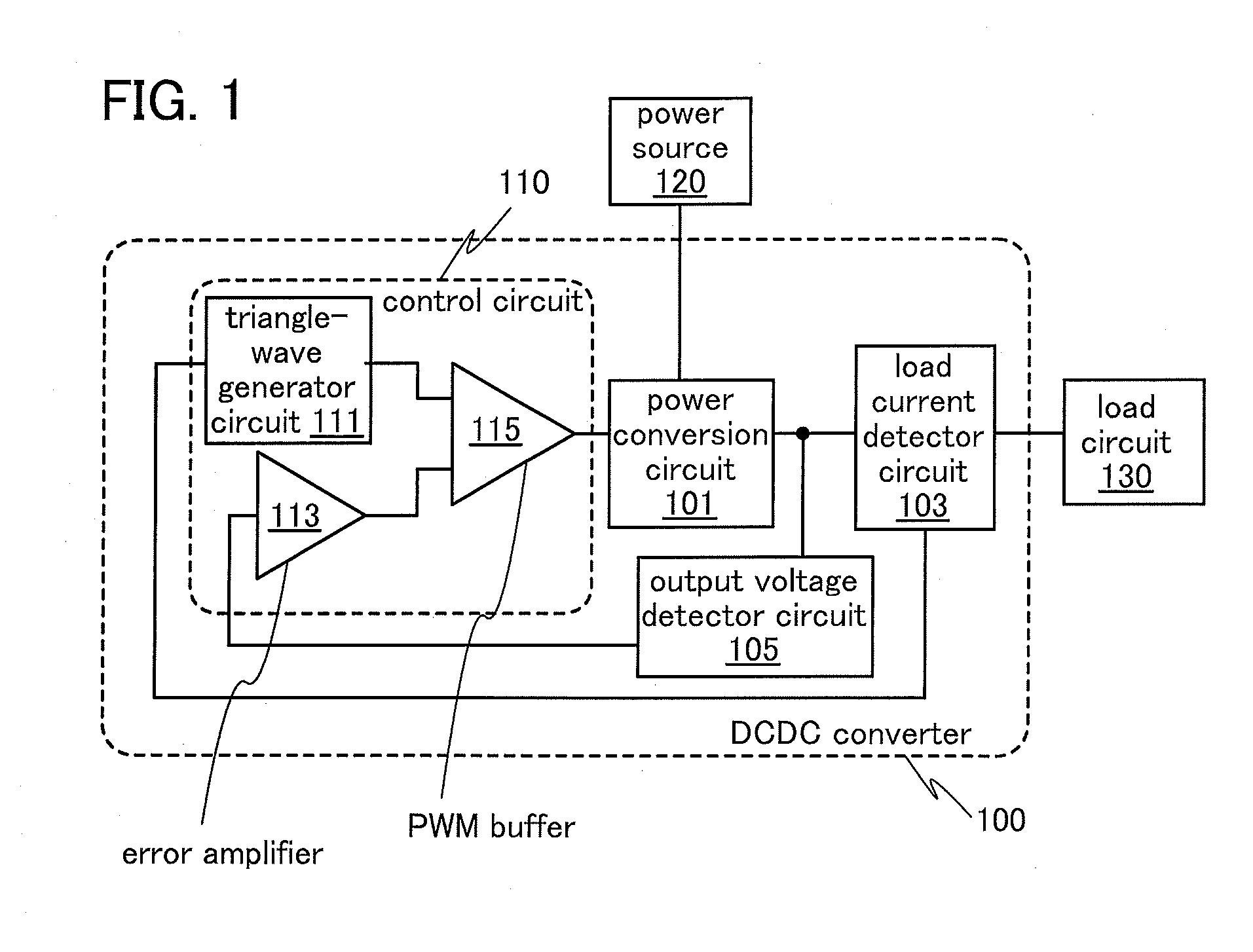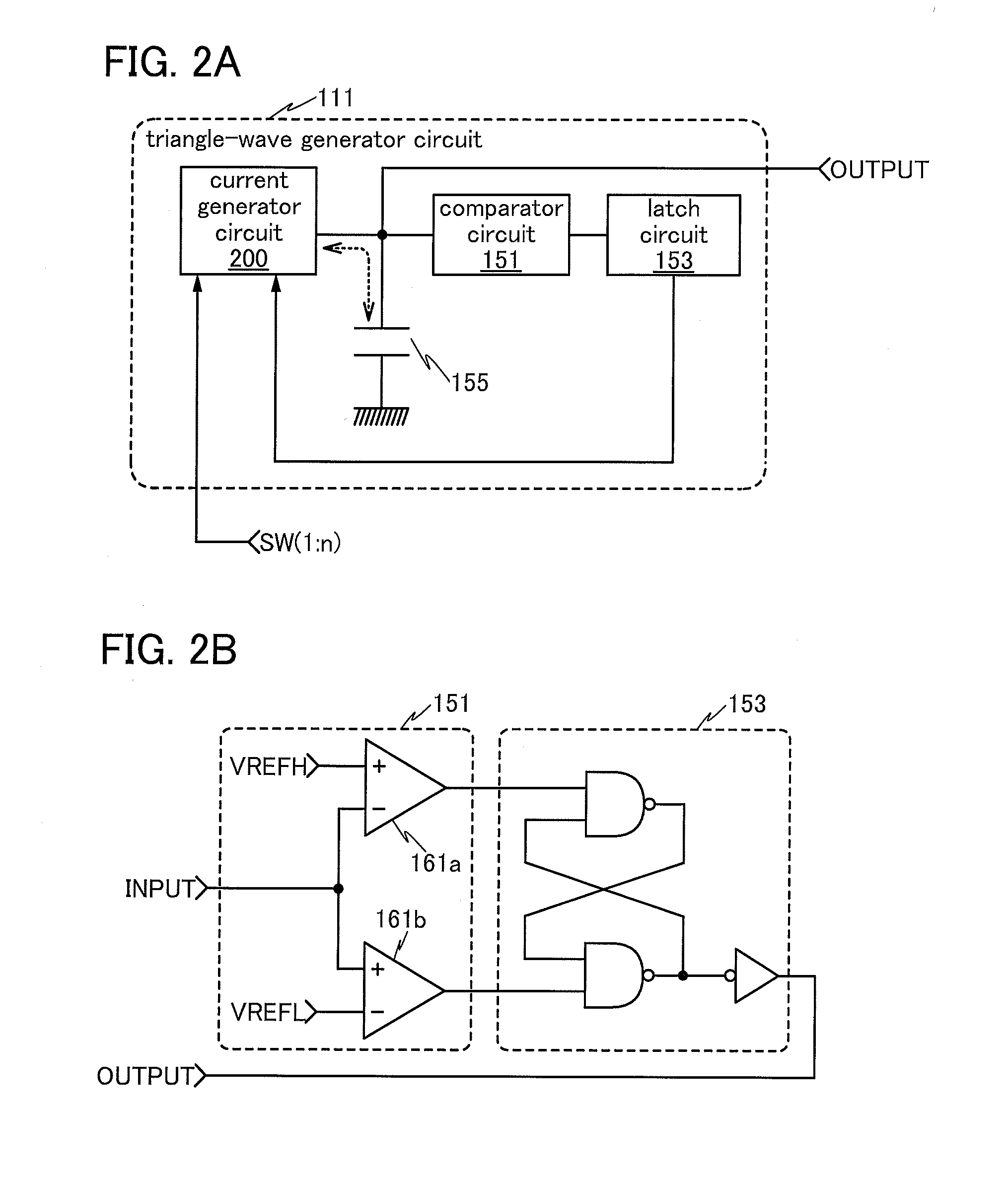Control circuit, DCDC converter, and driving method
a technology of control circuit and converter, applied in the field of control circuit, can solve the problems of inability to operate normally, inability to widen the range of oscillation frequency, and the current mirror cannot operate normally, and achieve the effect of optimizing power efficiency regardless of power consumption of the load circui
- Summary
- Abstract
- Description
- Claims
- Application Information
AI Technical Summary
Benefits of technology
Problems solved by technology
Method used
Image
Examples
embodiment 1
(Embodiment 1)
[0049]In this embodiment, structural examples of a DCDC converter and a control circuit to which a triangle-wave generator circuit with a wide variable range of oscillation frequency is applied will be described with reference to FIG. 1, FIGS. 2A and 2B, and FIG. 3.
[0050]FIG. 1 is a block diagram illustrating a configuration of a DCDC converter.
[0051]A power source 120 is connected to an input side of a DCDC converter 100 exemplified in this embodiment, and a load circuit 130 is connected to an output side thereof. The DCDC converter 100 includes a control circuit 110, a power conversion circuit 101 to which an output of the control circuit 110 and the power source 120 are connected, a load current detector circuit 103 connected to an output of the power conversion circuit 101, and an output voltage detector circuit 105.
[0052]The power conversion circuit 101 outputs a stable voltage to the load circuit 130 using power input from the power source 120 and a PWM control s...
embodiment 2
(Embodiment 2)
[0088]In this embodiment, a more specific example of the configuration of the current generator circuit described in Embodiment 1 will be described with reference to FIG. 4. Note that the configuration and functions described in this embodiment have a lot in common with those in Embodiment 1; therefore, the description is not repeated or is simplified for portions with the same configuration or function as Embodiment 1.
[0089]FIG. 4 is a circuit diagram illustrating a configuration of a current generator circuit 300 exemplified in this embodiment. As in the current generator circuit 200 described in Embodiment 1, a power supply line VDD, a ground potential line GND, and an input terminal INPUT are connected to the current generator circuit 300. A plurality of signal lines SW(1 to n) is supplied with a control signal from the load current detector circuit 103. From an output terminal OUTPUT, a forward or reverse current generated in the current generator circuit 300 is o...
embodiment 3
(Embodiment 3)
[0106]In this embodiment, an example of the configuration of the current generator circuit which is different from that in Embodiment 2 will be described with reference to FIG. 5. Note that the configuration and functions described in this embodiment have a lot in common with those in the above embodiments; therefore, the description is not repeated or is simplified for portions with the same configuration or function as the above embodiments.
[0107]FIG. 5 is a circuit diagram illustrating a configuration of a current generator circuit 400 exemplified in this embodiment. As in the current generator circuits described in the above embodiments, a power supply line VDD, a ground potential line GND, and an input terminal INPUT are connected to the current generator circuit 400. A plurality of signal lines SW(1 to n) is supplied with a control signal from the load current detector circuit 103. From an output terminal OUTPUT, a forward or reverse current generated in the curr...
PUM
 Login to View More
Login to View More Abstract
Description
Claims
Application Information
 Login to View More
Login to View More - R&D
- Intellectual Property
- Life Sciences
- Materials
- Tech Scout
- Unparalleled Data Quality
- Higher Quality Content
- 60% Fewer Hallucinations
Browse by: Latest US Patents, China's latest patents, Technical Efficacy Thesaurus, Application Domain, Technology Topic, Popular Technical Reports.
© 2025 PatSnap. All rights reserved.Legal|Privacy policy|Modern Slavery Act Transparency Statement|Sitemap|About US| Contact US: help@patsnap.com



